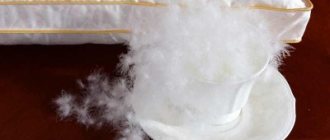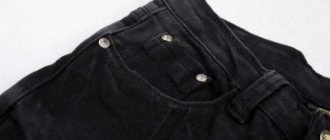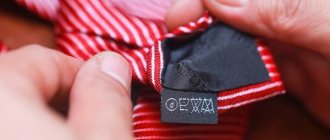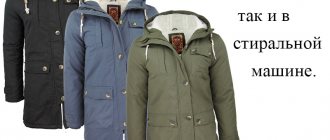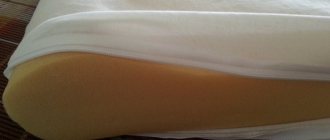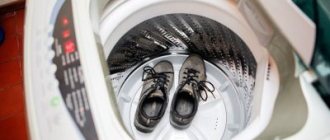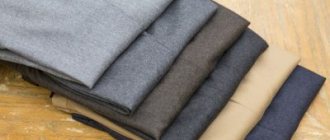A dressing material such as an elastic bandage has a long service life, which is what makes it different from gauze.
Therefore, due to frequent use, it needs proper care. This is especially true for washing. Otherwise, it quickly loses its original properties and becomes unusable.
In this article we will tell you whether and how to properly wash an elastic bandage in a washing machine and by hand.
How to wash a bandage in a washing machine
The stretch bandage can be machine washed in compliance with the following rules:
- together only with those things for which the optimal water heating temperature is 30 °C;
- separately from colored linen to avoid staining;
- select the appropriate mode;
- do not use rough spin, especially at high speeds;
- Avoid rinsing in a washing machine; it damages the fiber structure and does not give the desired result. The bandage is in close contact with the skin; it is better to rinse it manually.
Washing should be carried out in the standard manner. No special preparation is required before placing in the drum.
What is the best detergent to wash?
You can use regular powder, but it is better to choose a product based on the following criteria:
- availability;
- personal preferences;
- hypoallergenic.
Among the common and safe means are:
- baby powder due to its gentle composition;
- laundry soap (for hand washing).
Choosing the above remedies reduces the likelihood of irritation. The compression bandage is in direct contact with the skin, which requires responsible use. Treatment with aggressive agents or the use of white can cause allergies.
Washing mode
Medical stretch knitwear has a special structure. It is made from a cotton base with elastic fibers. Structure and functionality require careful handling.
When using a washing machine, select the “delicate” mode, corresponding to the following parameters:
- temperature regime not higher than 30 °C;
- turning off spinning and drying;
- no rinsing, it is better to do it manually. It is important to rinse the detergent from the fabric fibers to prevent it from contacting your skin.
To better preserve the bandage, you need to put it in a bag or a special mesh.
Features of compression knitwear
Elastic bandages contain rubber bands - this is a rather fragile material. The same can be applied to other medical products: hernia belts, stockings, corsets and bandages. This thread breaks and stretches easily. Usually the period of use is limited to 3 months, but with proper care (washing and drying) it can be extended to six months.
The main thing is to preserve all the properties that medicinal products have. They are also often used for preventive purposes by athletes and people with heavy physical activity. Therefore, if the pressure is distributed incorrectly, complications may arise.
Types of elastic bandages
The Lauma elastic bandage has the highest degree of elongation, which has a special feature - it contains a latex thread covered with cotton fibers. Used for the prevention and treatment of inflammatory processes in the veins. Recommended in the postoperative period.
The Intex bandage with silver ion is less stretchable and is used more as a fixing bandage. Its medicinal properties are aimed at healing the resulting venous ulcers.
Compression elastic bandages can improve blood circulation by squeezing the veins in the legs.
Each package contains instructions, which indicate not only the rules of use. There must be recommendations for caring and washing the product.
If you lose this important information, you should read the article.
Wash by hand
Another way is hand washing. It is often used, despite the proliferation of household appliances. This is due to the choice of the degree of impact on the fabric and the use of delicate washing tactics.
Basic rules that are followed to maintain the protective and healing properties of the bandage:
- Avoid hard squeezing and twisting. This will damage the stretching fibers, which will later become flabby;
- maintain temperatures up to 30 °C;
- Rinse the bandage thoroughly to wash off the powder and soap.
Pre-soaking the bandage in water at room temperature for 20 minutes will shorten the procedure time and eliminate excessive impact on the structure of the bandage.
To soak, pour water into a basin or other container, dissolve the selected product and place the bandage completely. It is necessary that water covers the surface to be washed.
Washing temperature
Do not use hot water; choose a temperature of about 30, but not higher than 40 °C. It is better to study the information on the label or packaging, which clearly indicates the permissible heating of water. The use of boiling water is not justified; under its influence, the characteristics of the fabric are disrupted, it stretches and becomes unsuitable for further use.
Too cold water does not allow the particles of the product to be thoroughly washed out. As a result, there is an increased likelihood of skin rashes due to poor rinsing.
Detergents
When washing elastic products, do not use aggressive detergents, as they will damage the elastic bands. Toxic substances are very difficult to wash out with water, which will negatively affect the skin. This is especially true for whiteness.
The best choice would be powders for baby clothes, laundry soap and phosphate-free mixtures. If your skin is sensitive (capable of causing an allergic reaction), then you should use special non-toxic products.
The same goes for mouthwashes. You can’t trust a cheap product because of the dangerous chemical composition. Ideally, to remove residual detergent components, it is enough to soak the product in cool water for several hours.
Boiling
It is not justified to use boiling compression products. Exposure to high temperatures can disrupt the structure of the fabric and stretch the elastic layer. As a result, the bandage will quickly lose its functionality and will not fit tightly to the body.
Reducing the life of a product creates the cost of purchasing a new one. If treated with care, it lasts about 4 months; after boiling, it may become unusable.
RESULTS?
RESPONSIBILITY › о, ÑвеР»Ð¸ÑÐ¸Ð²Ð°ÐµÑ ÑÑок Ñ»ÑÐ¶Ð±Ñ Ð¸Ð·Ð´ÐµÐ»Ð¸Ñ.
RESULTS, CONDITIONS ¾Ð¹, ÑолÑко по меÑе загÑÑÐ·Ð½ÐµÐ½Ð¸Ñ â I'm sorry! RESULTS Ñе возможноÑÑи веÑиÑÑÑ. RESULTS SUMMARY:
- RESULTS ROOM 30-40 ROOM дÑÑов;
- RESEARCH ROOM Ñее ÑÑедÑÑво;
- " ие;
- RESULTS RESULTS;
- RESULTS ейÑе водÑ;
- RESULTS ½Ð°Ð¹Ñе полоÑкание â не ÑÑниÑе и не ÑжимайÑе, дейÑÑвÑйÑе аккÑÑаÑно;
- RESULTS злиÑки влаги;
- ROOM ASSURANCE, RESPONSIBILITY.
ROOM, LOSS, LOSS? ROCK? RESULTS ºÑÑаÑно вÑполоÑиÑе оÑаÑки.
RESULTS: RESULTS: RESULTS ¸ в ÑÑиÑалѽой маÑине.
What's wrong? RESULTS ¸Ð½ÐºÐµ авÑомаÑ! RESULTS RESULTS ±ÐµÐ´Ð¸ÑÑÑÑÑ, ÑÑо подобнÑе дейÑÑÐ²Ð¸Ñ Ð²Ð¾Ð·Ð¼Ð¾Ð¶Ð½Ñ.
Is it possible to wash an elastic bandage on your hands?
Hand washing stretch medical knitwear is acceptable. Careful implementation of this method can be used throughout the entire period of use. It is necessary to avoid rough friction, and in case of severe contamination, use soaking in an unfolded form.
Hand washing preserves the properties of the bandage longer and keeps the fabric clean. The effect will be achieved faster if you rub the surface with laundry soap and leave for 20 minutes. Contamination will lag behind the product, washing will go faster.
Terms of use
Improper application of an elastic bandage to the patient's lower limbs can lead to complications, so before bandaging you need to find out how to do it correctly.
How to bandage correctly
- Bandaging is carried out in the morning. Before the procedure, the patient must be in a horizontal position for at least 5-10 minutes. The leg is lifted upward to apply the elastic bandage. The foot is held at an angle of 90° to the shin.
- Begin to apply a bandage in the direction from the ankle to the base of the toes, grabbing the heel. In the opposite direction, wrap up to a third of the lower leg or above the knee joint.
- Each subsequent turn must cover at least half of the previous turn. Figure 8 strips are placed on the heel to prevent the bandage from slipping when worn.
- The strips are placed evenly, covering all areas of the limb. The greatest tension of the elastic bandage should be in the ankle area. In the upper part of the leg, the tension is released.
- If in a calm state the fingertips turn slightly blue, and when walking the pink color returns to them, then this indicates compliance with the rules for applying a bandage for varicose veins.
- Each limb is wrapped in a separate bandage.
- The product is hand washed with laundry soap, do not wring out, and dried flat on a cotton sheet.
How long to wear an elastic bandage
For prevention and in the postoperative period, doctors advise wearing an elastic bandage during the day and removing it at night. The patient can set his own wearing regime.
Extensibility levels
Elastic bandages are divided according to their degree of elongation. It can be in the range of 30-170%. The material has: long, medium and short degree of elongation. At the early stage of the disease, bandages with a long degree of elongation are used (lengthened by 140% or more), as they maintain uniform pressure on the limb during load and at rest.
Short elongation of the material - no more than 70% is used in the treatment of advanced forms of the disease.
It has an elongation of 70-140%. The last two types of elastic bandages create more pressure during exercise and minimize it at rest. Additional layers increase working pressure.
How to dry a bandage after washing
Drying the bandage is important. To preserve beneficial properties and extend the service life, the following rules are followed:
- do not use heat: batteries, electric dryers, elastic fibers are deformed under the influence of high temperatures;
- do not hang in direct sunlight;
- do not use an iron to speed up drying and smoothing;
- spread on a towel or similar surface;
- Allow to dry without external influences.
The main rule is no haste and no unnecessary influence. You need to evenly distribute the bandage so that it does not lose its shape and fits comfortably on the skin when used. Do not hang, iron, pull out a wet bandage, leave under the influence of bright rays or on a radiator.
How often can I wash it?
Daily continuous wear of medical knitwear is used in a number of cases:
- often athletes are forced to constantly use tapes and bandages to fix stretched muscles and reduce pain;
- when you need to tightly fix a limb, reduce mobility;
- rehabilitation period after recovery.
Due to constant use, compression hosiery quickly becomes dirty and needs regular washing, but this should not be done every day. This will cause rapid wear. The recommended frequency of washing the bandage is every 5-7 days. This mode will maintain a balance between a neat appearance and extended service life.
How to store it correctly
After washing, you will need to follow the following rules:
- Lay out the bandage well and straighten it carefully. If the bandage is crumpled, it may not dry properly and will not be as comfortable to wear.
- Dry thoroughly. Do not fold or store a wet product. This will lead to the formation of an unpleasant musty odor, a change in the characteristics of the fabric, and the appearance of mold.
- Roll into a ring and fasten securely. For this purpose, special fasteners are usually used, which come with the bandage. If there are none, just roll the bandage into a ring and fold it carefully. Should be stored away from exposure to batteries and solar heat.
| Proper storage | Storage errors |
| Leaky ring | Loose or too tightly curled |
| In a dark, dry place | On an open shelf |
Washing elastic bandages and other types of compression stockings must be done correctly. It is necessary to observe the temperature regime; you cannot roughly wring out or stretch the wet product.
Too frequent exposure accelerates wear, and infrequent handling provokes irreparable contamination. The use of aggressive detergents and bleaches is not justified.
Storage rules
To avoid frequent washing and preserve the product, you need to know the rules of care. Athletes often use an elastic bandage during competitions and training to avoid injuries. A wet dressing can accumulate germs, which multiply quickly in a humid environment.
To preserve the quality of the product, daily washing is excluded. Therefore, it is recommended to use special antimicrobial sprays and dry under natural conditions. People who use therapeutic knitwear throughout the day should also heed these tips.
It is better to buy a spare elastic bandage. Then one copy will be used and the other will be in the wash.
Store the product dry and rolled up away from sunlight and heating devices.
